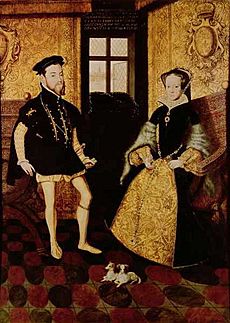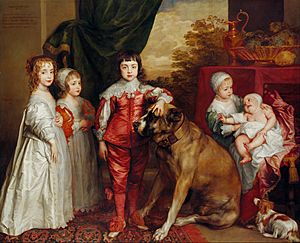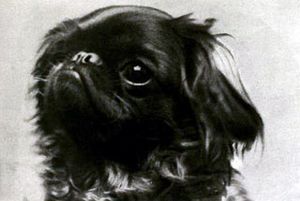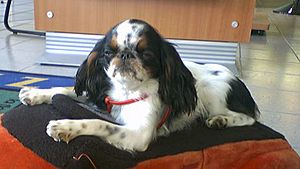King Charles Spaniel facts for kids

'King Charles' Colour
|
|||||||||||||||||||||||||
| Other names | English Toy Spaniel Toy Spaniel Charlies Prince Charles Spaniel Ruby Spaniel Blenheim Spaniel |
||||||||||||||||||||||||
|---|---|---|---|---|---|---|---|---|---|---|---|---|---|---|---|---|---|---|---|---|---|---|---|---|---|
| Origin | Great Britain | ||||||||||||||||||||||||
|
|||||||||||||||||||||||||
|
|||||||||||||||||||||||||
| Domestic dog (Canis lupus familiaris) | |||||||||||||||||||||||||
The King Charles Spaniel (also known as the English Toy Spaniel) is a small dog breed. It's a type of spaniel dog. In 1903, The Kennel Club brought together four different toy spaniel breeds under this one name. These included the Blenheim, Ruby, and Prince Charles Spaniels. Each of these added one of the four coat colors we see in the breed today.
These small spaniels might have come from East Asia. European traders probably brought them to Europe in the 16th century along the Spice Road. They became popular with English royalty during the time of Queen Mary I (1553-1558). They got their name because King Charles II loved them so much. He ruled from 1660 to 1685 and owned many small dogs. These dogs often went with him everywhere. Other famous owners included Queen Victoria (Dash) and her great-granddaughter Grand Duchess Anastasia Nikolaevna of Russia.
The modern King Charles Spaniel likely came from mixing old spaniels with other East Asian breeds. These included the Japanese Chin, Pekingese, and the Pug. This happened in the early 19th century. People did this to make their noses and snouts shorter, which was popular at the time. Later, people tried to bring back the look of King Charles II's original dogs. This led to the Cavalier King Charles Spaniel. The Cavalier is a bit bigger, with a flatter head and a longer nose. The King Charles Spaniel is smaller, with a rounder head and a flatter face.
Historically, the breeds that became the King Charles Spaniel were used for hunting. But they were too small for it. They still have some hunting instincts, but they don't have a lot of energy. They are much better suited to being lapdogs. This modern breed can have some health problems. These include heart issues and different eye problems.
Contents
History of the King Charles Spaniel

The King Charles Spaniel might share ancestors with the Pekingese and Japanese Chin. Red and white toy spaniels first appeared in paintings by Titian in the 1500s. Other artists like Palma Vecchio and Paolo Veronese also painted them. These dogs already had round heads and short noses. But their snouts were more pointed than they are today. These Italian toy spaniels might have been mixed with local small dogs like the Maltese. They may also have been mixed with dogs from China. The Papillon is a European dog that came from similar toy-sized spaniels.
The first time a toy spaniel was recorded in England was in a painting of Queen Mary I and King Philip. Mary, Queen of Scots, also loved small toy dogs. This shows that British royalty liked these dogs even before King Charles II.
King Henry III of France had many small spaniels called Damarets. A writer named John Caius mentioned a "Spainel-gentle, or Comforter" in 1570. He said this delicate dog came from Malta. It was only kept as a lapdog for "daintie dames."
Captain John Saris might have brought toy spaniels from Japan in 1613. Commodore Matthew C. Perry suggested this idea in the mid-1800s. He noted that dogs were common gifts. He thought Saris's trip introduced a Japanese type of spaniel to England.
King Charles II and His Dogs
In the 1600s, toy spaniels started appearing in paintings by Dutch artists. Spanish artists also painted them. These dogs were often tricolour, black and white, or all white. King Charles II of England loved the toy spaniel very much. This is why the dogs are named after him. He made the breed very popular during his time. Samuel Pepys wrote in his diary that the spaniels could go anywhere in Whitehall Palace. This included during important meetings. In 1667, Pepys wrote that the King was "playing with his dog all the while and not minding the business." Charles's sister, Princess Henrietta, was painted holding a small red and white toy spaniel.
Changes to the Breed
Toy spaniels stayed popular in the British court after Charles II. This continued through the time of Queen Anne. After 1688, the Pug dog came to Britain. This led to big physical changes in the King Charles Spaniel. By 1736, English toy spaniels started to have shorter noses. They looked different from the dogs seen in earlier paintings.
English toy spaniels were still popular in the 1700s. They often appeared in books and art. Writers described their features, like a "forehead large and high." They were still popular with ladies as lapdogs. Some weighed as little as 5 pounds (2.3 kg). But they were also thought to get overweight easily.
In the 1800s, toy spaniels were sometimes used for hunting. The Duke of Marlborough had a famous breed of small spaniels. They were red and white with long ears and short noses. His home, Blenheim Palace, gave its name to the Blenheim Spaniel. These small spaniels could hunt, but not for a whole day. They also struggled in difficult ground.
By 1830, the toy spaniel had changed a lot from Charles II's time. Their muzzles became very short, and their eyes grew larger. This was because people wanted dogs with shorter noses. Breeders mixed them with Pugs to make their noses even shorter. This made it harder for the dogs to smell.
Modern History and Recognition
From the 1500s, ladies often carried small toy spaniels. These dogs were called "Comforters." People believed these dogs could help with sickness. By the 1830s, this trend faded. The dogs went back to being called Toy Spaniels.
The dogs remained popular with royal families. In 1896, Otto von Bismarck bought a King Charles Spaniel for a lot of money. In 1899, the price for a King Charles or Blenheim was usually between $50 and $200.
In 1903, the Kennel Club tried to combine the King James (black and tan), Prince Charles (tricolour), Blenheim, and Ruby spaniels. They wanted to call them all "Toy Spaniel." But the Toy Spaniel Club disagreed. King Edward VII stepped in and said he preferred "King Charles Spaniel." So, that's what they became. In 1904, the American Kennel Club also combined the four types into one breed called the English Toy Spaniel. The Japanese Spaniel was kept as a separate breed.
Grand Duchess Anastasia Nikolaevna of Russia owned a King Charles Spaniel. In the 1920s, the Duchess of Marlborough bred many King Charles Spaniels at Blenheim Palace.
The Cavalier King Charles Spaniel started from a competition in 1926. An American named Roswell Eldridge offered a prize. He wanted dogs that looked like the old Blenheim Spaniels from King Charles II's time. These dogs had long faces and flat skulls. Breeders entered dogs they thought weren't good enough King Charles Spaniels. Even though Eldridge died before the new breed was fully formed, breeders created the first club for the Cavalier King Charles Spaniel in 1928. The Kennel Club first called them "King Charles Spaniels, Cavalier type." In 1945, the Kennel Club recognized the Cavalier as its own breed. The American Kennel Club recognized it in 1997.
Princess Margaret, Countess of Snowdon, continued the royal connection. She brought her King Charles Spaniel, Rolly, to Princess Anne's tenth birthday party in 1960. Elizabeth II also owned King Charles Spaniels.
In 2008, a TV show criticized the breeding of some pedigree breeds, including the King Charles Spaniel. It talked about health issues like syringomyelia in both King Charles and Cavalier breeds. Some animal welfare groups said that dog shows encouraged breeding unhealthy dogs.
The King Charles Spaniel is less popular than the Cavalier in both the UK and the US. In 2010, the Cavalier was the 23rd most popular breed in the US. The English Toy Spaniel was 126th. In the UK, the Cavalier is the most popular toy breed. Only 199 King Charles Spaniel puppies were registered in 2010. Because of these low numbers, the Kennel Club called the King Charles a Vulnerable Native Breed in 2003. This was to help promote the breed.
What Does a King Charles Spaniel Look Like?
The King Charles Spaniel has big, dark eyes and a short nose. It has a round head and a black line around its mouth. On average, it stands 9 to 11 inches (23 to 28 cm) tall at the shoulders. It has a small but sturdy body. The breed used to have its tail docked (shortened). But this is now illegal in the UK and some other European countries since 2006. Its ears are long and floppy, like a typical spaniel's. Its coat comes in four different colors. This is a trait it shares with the Cavalier King Charles Spaniel.
The four coat patterns come from the four original breeds.
- King Charles is black and tan. It has a black coat with reddish-brown markings on its face, legs, chest, and under its tail.
- Prince Charles is tricolored. It's mostly white with black patches. It also has reddish-brown markings in similar places to the King Charles.
- Blenheim is white with red patches. It should have a special red spot in the middle of its head.
- Ruby is a single, solid rich red color.
King Charles Spaniels are often confused with Cavalier King Charles Spaniels. But there are important differences. The main one is size. Cavaliers usually weigh between 13 and 18 pounds (5.9 and 8.2 kg). King Charles Spaniels are smaller, weighing 8 to 14 pounds (3.6 to 6.4 kg). Also, their faces are different. The Cavalier's ears are set higher, and its skull is flat. The King Charles's head is more domed (rounded). Finally, the King Charles usually has a shorter nose than the Cavalier.
The American Kennel Club has two groups for them: English Toy Spaniel (Blenheim and Prince Charles) and English Toy Spaniel (Ruby and King Charles). In the UK, the Kennel Club puts them all in one group.
Temperament
The King Charles Spaniel is a friendly dog. It's not usually a good watchdog because it's so friendly. But it might bark to tell its owners if someone is coming. It's not a very energetic breed. It loves being with its family and is mostly a lapdog. It can get along well with children and is tolerant of them. But it won't like rough handling. It prefers not to be left alone for long periods. It's known as one of the quietest toy breeds. This makes it good for living in apartments.
The breed can get along well with other pets. But the King Charles still has some hunting instincts. So, it might not always be friendly towards very small animals. It's smart enough to learn obedience commands. Because of its calm nature, it can be a good therapy dog for hospitals and nursing homes.
Health
Some King Charles Spaniels are born with a natural bobtail (a naturally short tail). This is allowed in dog shows. Not much health research has been done on this breed in Britain. But it has been part of studies in other countries, like the United States. The King Charles Spaniel can have eye and breathing problems. These are common in brachycephalic dogs (dogs with short, flat faces). It can also have hormone and metabolic diseases. These are common in small breeds. The breed also has some specific health conditions. The average lifespan is 10 to 12 years. The breed should be able to have puppies naturally.
Eye and Heart Conditions
Eye problems seen in King Charles Spaniels include cataracts (cloudy eyes). They can also have corneal dystrophy (a problem with the clear front part of the eye). Other issues are distichia (extra eyelashes that irritate the eye) and entropion (eyelids that roll inward). They can also have microphthalmia (small eyes) and keratitis (inflammation of the eye). King Charles Spaniels have a higher risk of distichia compared to other breeds. Eye problems can start from six months old for cataracts. Corneal dystrophy might appear between two and five years old.
Heart conditions in King Charles Spaniels include mitral valve disease. This is when a heart valve wears out. It causes blood to flow backward in the heart. This can lead to congestive heart failure. Patent ductus arteriosus is another heart problem. This is when blood flows from the heart back into the lungs. Both conditions can lead to heart failure and can be passed down from parents.
Other Common Issues
Because they are brachycephalic (flat-faced), King Charles Spaniels can be sensitive to anesthesia. This is because they have extra tissue in their throat. Anesthesia relaxes muscles, which can block their narrow airways. These narrow airways can also make it hard for them to exercise. It also makes them more likely to get heat stroke.
Other problems found in the King Charles Spaniel include:
- Hanging tongue: A problem where the tongue can't go back into the mouth.
- Diabetes: This can sometimes be linked to cataracts.
- Cleft palate: A gap in the roof of the mouth.
- Umbilical hernia: A soft lump near the belly button.
The English Toy Spaniel Club of America suggests fixing umbilical hernias only if other surgery is needed. This is because surgery can be risky for flat-faced breeds. Some King Charles Spaniels can also have patella luxation. This is when the kneecap slips out of place.
Some breed traits might look like health problems but are not.
- Open fontanelle: Young puppies can have a soft spot on their skull. This is common in dogs under one year old. A problem from this can be hydrocephalus (water on the brain). This can cause brain problems that might need the dog to be put down.
- Fused toes: This is when two or more toes are joined together. This is a normal trait for the breed and not a health concern.
Urban Myth
There's a popular story that King Charles II made a special rule. It says that King Charles Spaniels can go anywhere in the UK. This would mean they could go into places that usually don't allow dogs. A version of this story says they can even go into the Houses of Parliament. This myth is sometimes told about the Cavalier King Charles Spaniel too.
However, the UK Parliament website says this is not true. They have looked into it and found no such law. There's also no proof of any such law covering the rest of the UK. A spokesperson for the Kennel Club said they have heard this story. But their research has not found any evidence of such a rule.
See also
 In Spanish: Toy spaniel inglés para niños
In Spanish: Toy spaniel inglés para niños
- Cavalier King Charles Spaniel
- Toy dog
Images for kids
-
A painting of a King Charles Spaniel by Édouard Manet, from c. 1866










